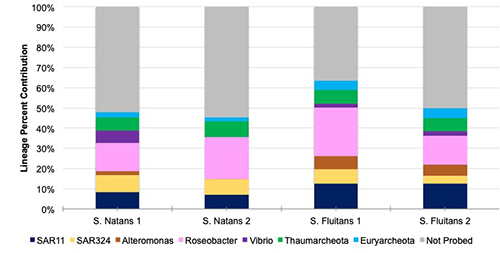
Sargassum DOM and Microbiome
Sargassum DOM and Microbiome
Sargassum is a genus of brown seaweed found throughout the temperate and tropical oceans of the world, including the Sargasso Sea. Unlike many species of seaweed that anchor to the ocean floor, Sargassum floats on the ocean’s surface, buoyed by small, gas-filled structures called pneumatocysts. The seaweed often forms extensive mats large enough to be seen by satellites in space. For a sea that lacks land boundaries, these mats serve as important habitat and nursery grounds for over 100 different marine organisms, including sea turtles, eels, and a variety of commercially-important fish, such as mahi mahi and amberjacks. In fact, within the Sargasso Sea, the seaweed is considered a “keystone species” that defines the ecosystem and supports a high level of biodiversity.
Sargassum DOM and Microbiome
Within the Sargasso Sea, there are two distinct species of Sargassum: Sargassum natans and Sargassum fluitans. In addition to serving as a host for larger organisms, the Sargassum also supports diverse microbial communities, comprising bacteria and archaea (bacteria-like, single-celled prokaryotic organisms), that are referred to as the Sargassum’s microbiome.

An image of the bacteria associated with Sargassum. The bacteria (white cells) are stained and imaged under UV light at x 1000 magnification.
A study done in 2019 by Bermuda Program intern Zoe Skinner used microscopy methods to identify specific types of microbiota within the Sargassum microbiome. All seven lineages were found, with Roseobacter contributing the largest percentage to the total bacterial community. Both Sargassum species had similar microbiomes.

A stacked bar chart showing the seven types of microbiota found within the Sargassum microbiome of both S. natans and S. fluitans.
Despite the fact that the Sargasso Sea has low levels of dissolved phosphorus and nitrogen—which are usually required for the growth of algae and other primary producers—Sargassum not only survives, but has somehow managed to thrive. The hardiness of Sargassum in these conditions, which many oceanographers refer to as an “ocean desert,” make the algae an interesting case study for researchers.
One theory that explains how Sargassum can persist in this nutrient-depleted environment centers on the ability of the algae’s microbial community, or microbiome, to process methylphosphonate (MPn) and use it as a source of phosphate and methane.
Led by researchers at BIOS and UC Santa Barbara (California), The Sargassum Dissolved Organic Matter (DOM) and Microbiome Project aims to understand the properties of the microbiota associated with Sargassum by using microbial and biomass isotope analysis and nutrient analysis.
Questions being investigated include:
- What microbes are found in the Sargassum microbiome?
- Are any of these microbes able to process methylphosphonate (MPn)?
- Can ocean bacteria use the organic matter produced by Sargassum?
- Do ocean bacteria require certain nutrients to use the organic matter produced by Sargassum?
BIOS research specialist Rachel Parsons, who is leading this project, suggests that Sargassum may actively select certain types of archaea that can break down methylphosphonate to be part of its microbiome. These bacteria would benefit from the dissolved organic matter (DOM) produced by the Sargassum during photosynthesis and, in turn, break down any methylphosphonate found in the ocean; thereby, giving the Sargassum its much-needed phosphate source. An example of such a bacteria is Roseobacter, which has been shown to break down methyphosphonate and is present in the microbiomes of both Sargassum species (pink portion of the stacked bar chart shown above).
In 2020, Parsons and Skinner will be setting up an incubation experiment to see how oceanic bacteria respond to Sargassum DOM and if additions of methyphosphonate increase the response.
“Previous experiments by BIOS NSF Research Experiences for Undergraduates student Tiburon Benevides showed that, while bacteria responded to Sargassum DOM, the response was considerably higher when methylphosphonate was also added,” Parsons said. “This year, we intend to see if additions of both methylphosphonate and ammonium further increase that response. Ammonium is used as a nitrogen source, so the planned experiments will look at additions of all growth requirements: carbon, phosphorus and nitrogen.”
Funding for this project is provided by BIOS-SCOPE, the National Science Foundation (NSF) Research Experiences for Undergraduates (REU) program, and the BIOS Bermuda Program.
Sargassum and Microplastics
Marine microplastics, or plastic fragments less than 5mm in length, are present in the world’s ocean, often floating on the surface. These microplastics can become entangled in Sargassum, resulting in microplastics concentrating within Sargassum floats. This leads to a number of research questions, including: Does the Sargassum microbiome influence the bacteria found on the microplastics? Does the microplastics biofilm have a different community of bacteria than the Sargassum? What is the biofilm community and does it include species capable of breaking down plastics?
A study done by BIOS Fall Semester student, Bharathi Kolluru, looked at the bacterial community of Sargassum and microplastics. Kolluru looked at five groups of samples: healthy Sargassum with no plastic, Sargassum with plastics removed, Sargassum with plastics, plastic biofilm, and plastic biofilm from plastic associated with Sargassum. The plastic biofilm alone and Sargassum and plastics together had larger portions of Alteromonas and Flavobacterales, species of bacteria known as "weed species." However, the healthy Sargassum with no plastics and Sargassum with the plastics removed both had a higher portion of Roseobacter than the plastics alone.

A stacked bar chart showing the four types of bacteria found within the Sargassum microbiome and microplastics biofilm.
In 2020, BIOS Ocean Academy intern An-Mei Daniels will be further investigating the bacteria found on microplastics using microscopy and molecular methods.
“We are hoping to find bacteria capable of breaking down microplastics and will be working with colleagues at Oregon State University who are more familiar with microplastic degradation”, said Parsons.
Project Contact
Rachel Parsons
Research Specialist, Microbial Ecology Laboratory
[email protected]